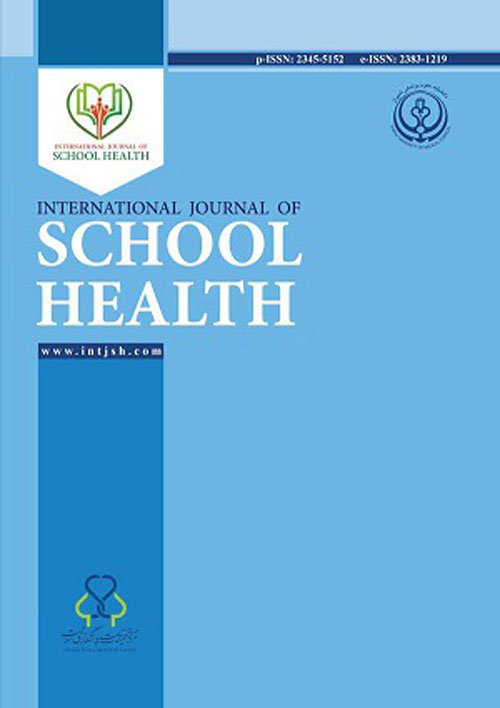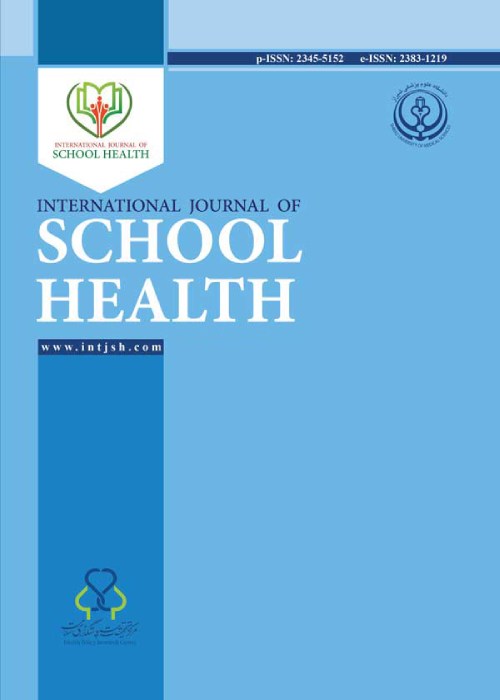فهرست مطالب

International Journal of School Health
Volume:3 Issue: 4, Autumn 2016
- تاریخ انتشار: 1395/08/09
- تعداد عناوین: 8
-
-
Page 1BackgroundThe health of children and adolescents has been one of the main concerns of parents and teachers. Today, magazines are taken into account as useful tools for training these vulnerable groups..ObjectivesThe aim of this study was to analyze the health contents of children and adolescent magazines during years 2013 to 2014..Materials And MethodsThis was an applied research and the method was content analysis. The analysis unit was page (text and image) of all children and adolescent magazines published during years 2013 and 2014 in Iran. The research was done based on Shannon entropy. The validity of the data-gathering tool was confirmed by experts in health education. Test-retest was used to determine the reliability of the tool and the correlation coefficient was 0.84..ResultsIn the mentioned magazines, most attention was towards nutrition components with 0.139 importance coefficient and sports and physical activity with 0.123 importance coefficient. While the least attention was devoted to puberty health component with 0.078 importance coefficient and smoking and drugs with 0.082 importance coefficient..ConclusionsRegarding the important role of magazines in preparing children and adolescences to have a healthy and happy life, it seems that despite their success in some areas, magazines couldnt help them in some categories such as puberty and addiction..Keywords: Child Health Services, Adolescent Health Services, Publications, Hygiene
-
Page 2BackgroundNoncommunicable diseases (NCDs) are the main causes of mortality and disability in the world. In order for a campaign against NCDs risk factors it is necessary to estimate the extent of their prevalence for their decrease through appropriate interventions..ObjectivesThe aim of this study was to determine the prevalence of NCDs risk factors among secondary school students in Birjand city, east of Iran..
Patients andMethodsIn this cross-sectional study, 369 secondary school students aged between 15 - 20 years were selected using randomized cluster sampling in 2013. To gather data, the national health system questionnaire regarding NCDs with a stepwise approach was used. The data were derived by health trained workers through face-to-face interview, and physical assessments including height, weight, and blood pressure in every school. Finally, the obtained data were analyzed using the chi-square and Fishers exact tests with the SPSS software version 18..ResultsFrom a total of 369 students in the study, 180 cases (48.8%) were boys with the mean age of 16.98 ± 1.04 years. The prevalence rates of cigarette, and hookah smoking were 2.4% and 18.4%, respectively. Overweight and obesity were diagnosed in 15.2% of the population. The prevalence of hypertension was observed in 6% of the participants. The prevalence rates of hookah smoking and hypertension in boys were significantly higher than in girls (PConclusionsGenerally speaking, the critical prevalence of NCDs risk factors was observed. Regarding the more favorable effect of preventive measures on adolescents, planning for appropriate interventions to improve lifestyle to prevent various risk factors must be taken into account..Keywords: Prevalence, Risk Factors, Chronic Disease, Adolescent, Iran -
Page 3BackgroundTest anxiety is one of the most important variables which affect the mental health of students in primary schools. Therefore, it is crucial to identify the factors that influence test anxiety..ObjectivesThe current study aimed to investigate the mediation effect of self-esteem on the relationship between self- efficacy social support and test anxiety..
Patients andMethodsParticipants were 374 elementary students (179 boys; 195 girls) who completed the Rosenberg self-esteem scale, the perceived social support from family, the self-efficacy questionnaire and the test anxiety inventory. The relationships between the variables were examined via path analysis. Data analysis was conducted using descriptive and inferential statistics by statistical package for social sciences (SPSS) and analysis of moment structures (AMOS) software..ResultsFindings showed that self-efficacy was negatively related with test anxiety (-0.23, PConclusionsThese findings support the negative correlation of self-efficacy, social support, and self-esteem with test anxiety. The obtained model is appropriate to explain the test anxiety of elementary students..Keywords: Self, Esteem, Self, Efficacy, Family Social Support, Test Anxiety -
Page 4BackgroundDefense mechanisms are psychological operations which often prevent stressful norms, beliefs, and values to emerge and reach the level of consciousness..ObjectivesThe aim of the present study was to investigate the effect of Rational Emotive Behavioral Therapy (REBT) on defense mechanisms of boy high school students at east Azerbaijan, Iran..
Patients andMethodsThis experimental study was conducted on all male students (n = 680) enrolled in the second and third grades of high school in east Azerbaijan, Iran, during 2014 - 2015. To select the sample, first the defense style questionnaire (DSQ, Andrews et al. 1993) was completed by 150 students and among those who had the required conditions to participate in the study, 30 students were randomly selected and divided into the control (n = 15) and experimental (n = 15) groups. Eight sessions of the REBT were conducted on the experimental group. Data were analyzed using ANCOVA analysis with the SPSS software version 20..ResultsResults showed that after the interventions, a significant relationship was found between the control and experimental groups in terms of using mature and immature defense mechanisms (P 0.05). In this regard, the rational emotive behavioral group counseling leads to reduction of using immature defense mechanisms (F(1,2) = 43.55, P = 0, ηp2 = 0.67) and increase using of mature defense mechanisms (F(1,2) = 19.78, P = 0, ηp2 = 0.42) among the students..ConclusionsThe results of the current study indicate that the REBT therapy can balance and improve defense mechanisms among male high school students..Keywords: Rational Emotive Behavioral Therapy, Defense Mechanisms, Students -
Page 5BackgroundCoping with painful events and unfavorable emotions is a special goal for every human being. The ability to effectively cope with these events is called resilience. Among high-school students who are prone to facing many stressful incidents, this construct has had special importance because resilience predicts mental and physical health of students in the future to a great degree, and it will have many other positive effects as well..ObjectivesIn this study, the effect of intimacy with parents on the resilience with the mediator roles of life satisfaction and lack of depression was studied in the framework of next generation of structural equations modeling (partial least squares)..Materials And MethodsThis research design is correlation. The statistical population comprised of all high school students studying at public high-schools in the Baharestan county, Tehran, Iran. The sample included 386 students. They were selected using the random cluster sampling method and they all answered to a questionnaire, which was designed based on the conceptual model of the study..ResultsThe SmartPLS 2.0 software was used to test the hypotheses. All hypotheses were confirmed at either the PConclusionsThe conceptual model of the present study reveals a good fit with the data, which shows the importance and the positive effect of intimacy with parents, life satisfaction and lack of depression on resilience..Keywords: Resiliency, Parental Intimacy, Life Satisfaction, Depression
-
Page 6BackgroundIn the recent years, understanding school environments contributions to students development has been of increasing concern. One of the variables that could be affected by the school moral atmosphere is moral development..ObjectivesThe purpose of this study was to assess the effect of students perception of school moral atmosphere on their moral development..
Patients andMethodsThe statistical population consisted of the students of Shiraz elementary schools. Multi-stage cluster random sampling was used to select 412 participants (grade four to six students) from different schools. They completed self-report questionnaires tapping school moral atmosphere questionnaire (SMAQ) and moral judgment test (MJT) in the classroom during a school lesson. All descriptive statistics, regression, and confirmatory factor analyses were performed with the SPSS 19 software..ResultsSimultaneous multiple regression of school moral atmosphere on students moral development showed that subscales of the school moral atmosphere predict students moral development. These findings are discussed fully in the results section..ConclusionsThe findings showed that perception of school moral atmosphere is a significant factor in predicting students moral development. More specifically, these findings highlight the importance of improving the moral atmosphere of schools for the benefit of all members of the school community..Keywords: Moral Atmosphere, Moral Development, Elementary Student -
Page 7BackgroundOne of the most fundamental constructs in the positive psychology is the quality of life. Quality of life refers to the emotional, social and physical health of individuals and their ability to do daily activities..ObjectivesThe present study aimed to investigate the mediating role of resilience in relationship between attachment styles and quality of life..Materials And MethodsThe population of the study consisted of all male and female high school students in Babolsar, Iran, in the academic year 2014 - 2015. Participants included 367 high school students (226 females and 141 males) from Babolsar city, Iran, selected by multi-stage cluster sampling method. Participants completed attachment styles, quality of life and resilience scales. The research conceptual model was analyzed and assessed using simultaneous sequential regression method and the steps proposed by Baron and Kenny (1986). All analyses were performed by SPSS ver. 22 software..ResultsThe obtained results showed that: 1) the secure attachment style was a positive predictor of resilience (PConclusionsThis finding confirms the resiliency theory indicating that secure families bring up children resiliently and increase the quality of their lives..Keywords: Resilience, Quality of Life, Attachment Styles
-
Page 8BackgroundIron deficiency, as the most common nutritional deficiency, often occurs in the pediatric age group due to rapid growth and low dietary iron content..ObjectivesThe present study aimed to assess the relationship between microcytic hypochromic anemia and blood lead level below the standard acceptable upper range in children aged between one and ten years..MethodsIn this study, 27 cases, who fulfilled the inclusion criteria were assigned to group A, as hypochromic microcytic anemia with iron deficiency. Another 18 hypochromic microcytic anemia cases with normal ferritin levels were assigned to group B. Besides, 20 healthy children were chosen as the control group. All the statistical analyses were performed using the SPSS statistical software. P values ofResultsThe children in group A showed significant correlations between lead levels and hemoglobin (-0.770; P values = 0.001), mean corpuscular volume (MCV) (-0.679; P values = 0.001), and ferritin (-0.509; P valuesConclusionsOur study results imply that there is no secure threshold for blood lead level at which, lead begins to cause interruption with hematologic parameters in young children..Keywords: Lead, Iron Deficiency, Microcytic Hypochromic Anemia, Pediatric


